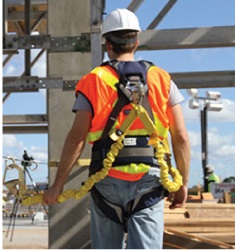This article sheds light on an important issue that often seems unclear and should never be overlooked. Due to regulatory changes in recent years, your fall prevention plan may need to be reviewed.
From what height must I protect myself against falls?
- 3 meters (10 feet)?
- 1.8 meters (6 feet)?
- Any height that poses a hazard?
At the end of this short reading, you will have the answer!
Firstly, it is important to know that compliant fall protection systems do not always perform well, especially at low heights.
When it comes to protecting workers, apart from the fall itself, it is imperative to consider the other surrounding risks it such as:
- The risks of hitting the ground
- The risk of hitting obstacles or other objects during the fall
- Risks related to rescue
- Risks related to the performance of the fall protection system
The identification of the limitations of the equipment used in the design of active fall protection systems is very important. In addition, to assist the engineer in the design, the CSA Z259.16 standard on Design of Active Fall Protection Systems is essential.
To answer the initial question, particular attention must be paid to what the Regulation respecting occupational health and safety and the Safety Code for the Construction industry state.
Retrieved from Regulation respecting occupational health and safety :
33.1. Cases where workers must be protected : Workers shall be protected against falls in the following cases :
- if they are at risk of falling more than 3 m unless they are only using a means of access or exit;
- if they are at risk of falling:
- into a liquid or dangerous substance;
- on a moving component;
- on equipment or material that constitute a danger;
- from a height of 1.5 m or more in a well, a basin, a tank, a reservoir, a vat, a container for the storing or mixing of substances, or where the workers are handling a load.
33.2. Safety measures : Where workers must be protected in accordance with section 33.1 and subject to section 33.3, one or several of the following measures shall be taken by the employer to ensure the safety of workers :
- change the work position of workers so that they can work on the ground or on another surface from which they are not at risk of falling;
- install guardrails or a system which, by limiting the movements of workers, prevent them from being at risk of falling;
- use common protective devices and equipment, such as a safety net in accordance with section 354;
- ensure that workers wear safety harnesses secured to an anchorage system by a fall arrest connecting device, in accordance with section 347 when they are working. When workers cannot position themselves without the help of their fall arrest connecting device, ensure that they also use a means of positioning, such as a plank on brackets, a positioning tether or strap, a suspension cable or a platform;
- use another means that ensures equivalent safety for workers.
Retrieved from the Safety Code for the construction industry:
2.9.1. Safety measures: Workers shall be protected against falls in the following cases:
- if they are at risk of falling more than 3 m from the place where he is working;
- if they are at risk of falling:
a) into a dangerous liquid or substance;
b) on a moving component;
c) on equipment or material that constitute a danger;
d) from a height of 1.2 m or more where they use a wheelbarrow or a vehicle.
In such cases and subject to section 2.9.2, one or several of the following measures shall be taken by the employer to ensure the safety of workers:
- change the work position of workers so that they can work on the ground or on another surface from which they are not at risk of falling;
- install guard-rails or a system which, by limiting the movements of workers, prevent them from being at risk of falling;
- use common protective devices and equipment, such as safety nets;
- ensure that workers wear safety harnesses secured to an anchorage system by a fall arrest connecting device, the whole in accordance with sections 2.10.12 and 2.10.15 when they are working. When workers cannot position themselves without the help of their fall arrest connecting device, ensure that they also use a means of positioning, such as a plank on brackets, a positioning tether or strap, a suspension cable or a platform;
- use another means that ensures equivalent safety for workers.
So, how high should you protect yourself from falls?
The answer is simple: You must protect yourself against falls from any height that presents a hazard.
In conclusion, the RROHS and the Safety Code for the construction industry are very strict regulations and companies that require protection at more than 3m or 1.8m may in some cases not comply with the regulatory requirements in force.
The Barry team is here to help you at any time if you have fall prevention and protection challenges. Click here to contact the Barry Team.
Posted by Marc-André Pilon on







